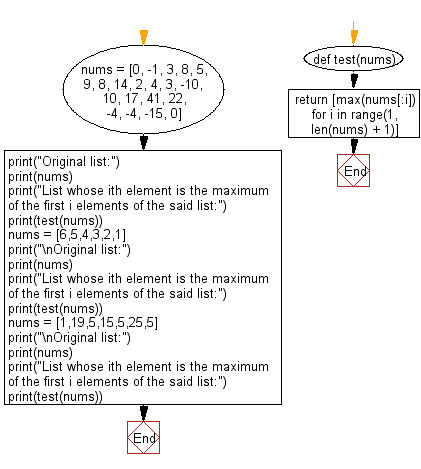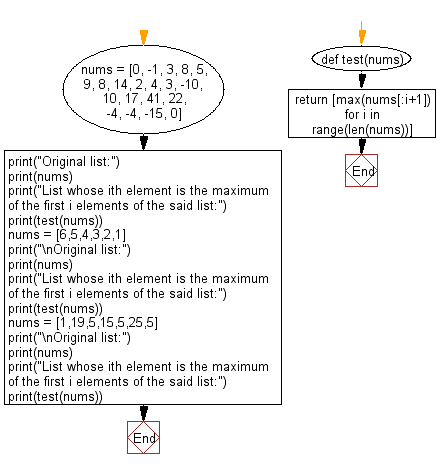Python: Create a list whose ith element is the maximum of the first i elements of the input list
Python Programming Puzzles: Exercise-24 with Solution
Write a Python program to create a list whose ith element is the maximum of the first i elements from a input list.
Input: [0, -1, 3, 8, 5, 9, 8, 14, 2, 4, 3, -10, 10, 17, 41, 22, -4, -4, -15, 0] Output: [0, 0, 3, 8, 8, 9, 9, 14, 14, 14, 14, 14, 14, 17, 41, 41, 41, 41, 41, 41] Input: [6, 5, 4, 3, 2, 1] Output: [6, 6, 6, 6, 6, 6] Input: [1, 19, 5, 15, 5, 25, 5] Output: [1, 19, 19, 19, 19, 25, 25]
Pictorial Presentation:

Sample Solution-1:
Python Code:
#License: https://bit.ly/3oLErEI
def test(nums):
return [max(nums[:i]) for i in range(1, len(nums) + 1)]
nums = [0, -1, 3, 8, 5, 9, 8, 14, 2, 4, 3, -10, 10, 17, 41, 22, -4, -4, -15, 0]
print("Original list:")
print(nums)
print("List whose ith element is the maximum of the first i elements of the said list:")
print(test(nums))
nums = [6,5,4,3,2,1]
print("\nOriginal list:")
print(nums)
print("List whose ith element is the maximum of the first i elements of the said list:")
print(test(nums))
nums = [1,19,5,15,5,25,5]
print("\nOriginal list:")
print(nums)
print("List whose ith element is the maximum of the first i elements of the said list:")
print(test(nums))
Sample Output:
Original list: [0, -1, 3, 8, 5, 9, 8, 14, 2, 4, 3, -10, 10, 17, 41, 22, -4, -4, -15, 0] List whose ith element is the maximum of the first i elements of the said list: [0, 0, 3, 8, 8, 9, 9, 14, 14, 14, 14, 14, 14, 17, 41, 41, 41, 41, 41, 41] Original list: [6, 5, 4, 3, 2, 1] List whose ith element is the maximum of the first i elements of the said list: [6, 6, 6, 6, 6, 6] Original list: [1, 19, 5, 15, 5, 25, 5] List whose ith element is the maximum of the first i elements of the said list: [1, 19, 19, 19, 19, 25, 25]
Flowchart:

Visualize Python code execution:
The following tool visualize what the computer is doing step-by-step as it executes the said program:
Sample Solution-2:
Python Code:
#License: https://bit.ly/3oLErEI
def test(nums):
return [max(nums[:i+1]) for i in range(len(nums))]
nums = [0, -1, 3, 8, 5, 9, 8, 14, 2, 4, 3, -10, 10, 17, 41, 22, -4, -4, -15, 0]
print("Original list:")
print(nums)
print("List whose ith element is the maximum of the first i elements of the said list:")
print(test(nums))
nums = [6,5,4,3,2,1]
print("\nOriginal list:")
print(nums)
print("List whose ith element is the maximum of the first i elements of the said list:")
print(test(nums))
nums = [1,19,5,15,5,25,5]
print("\nOriginal list:")
print(nums)
print("List whose ith element is the maximum of the first i elements of the said list:")
print(test(nums))
Sample Output:
Original list: [0, -1, 3, 8, 5, 9, 8, 14, 2, 4, 3, -10, 10, 17, 41, 22, -4, -4, -15, 0] List whose ith element is the maximum of the first i elements of the said list: [0, 0, 3, 8, 8, 9, 9, 14, 14, 14, 14, 14, 14, 17, 41, 41, 41, 41, 41, 41] Original list: [6, 5, 4, 3, 2, 1] List whose ith element is the maximum of the first i elements of the said list: [6, 6, 6, 6, 6, 6] Original list: [1, 19, 5, 15, 5, 25, 5] List whose ith element is the maximum of the first i elements of the said list: [1, 19, 19, 19, 19, 25, 25]
Flowchart:

Visualize Python code execution:
The following tool visualize what the computer is doing step-by-step as it executes the said program:
Python Code Editor :
Have another way to solve this solution? Contribute your code (and comments) through Disqus.
Previous: Find the indices for which the numbers in the list drops.
Next: Find the XOR of two given strings interpreted as binary numbers.
What is the difficulty level of this exercise?
Test your Programming skills with w3resource's quiz.
Python: Tips of the Day
Find current directory and file's directory:
To get the full path to the directory a Python file is contained in, write this in that file:
import os dir_path = os.path.dirname(os.path.realpath(__file__))
(Note that the incantation above won't work if you've already used os.chdir() to change your current working directory, since the value of the __file__ constant is relative to the current working directory and is not changed by an os.chdir() call.)
To get the current working directory use
import os cwd = os.getcwd()
Documentation references for the modules, constants and functions used above:
- The os and os.path modules.
- The __file__ constant
- os.path.realpath(path) (returns "the canonical path of the specified filename, eliminating any symbolic links encountered in the path")
- os.path.dirname(path) (returns "the directory name of pathname path")
- os.getcwd() (returns "a string representing the current working directory")
- os.chdir(path) ("change the current working directory to path")
Ref: https://bit.ly/3fy0R6m
- New Content published on w3resource:
- HTML-CSS Practical: Exercises, Practice, Solution
- Java Regular Expression: Exercises, Practice, Solution
- Scala Programming Exercises, Practice, Solution
- Python Itertools exercises
- Python Numpy exercises
- Python GeoPy Package exercises
- Python Pandas exercises
- Python nltk exercises
- Python BeautifulSoup exercises
- Form Template
- Composer - PHP Package Manager
- PHPUnit - PHP Testing
- Laravel - PHP Framework
- Angular - JavaScript Framework
- Vue - JavaScript Framework
- Jest - JavaScript Testing Framework
